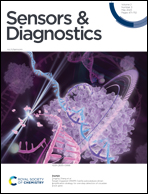Noninvasive and point-of-care screening of snoring by breath monitoring using ion-in-conjugation polymer-based humidity sensors†
Abstract
Snoring monitoring is a valid method to assess human health. However, it is challenging to sense the humidity of breath flows that have huge oscillations, requiring highly robust sensors. Herein, a humidity sensor based on ion-in-conjugation croconate polymers was fabricated for snoring monitoring for the first time. The sensor showed rapid response/recovery to monitor human breathing. It has a wide working range from 11% to 95% RH (relative humidity) with a time stability of up to 28 800 seconds (8 hours). Normal breath, snoring, and apnea are distinguished and recorded timely. The fabricated noninvasive and point-of-care snoring detection device exhibits comparable accuracy to commercial devices, manifesting the potential of ion-in-conjugation polymers in future breath monitoring systems.

- This article is part of the themed collection: Sensors in a Digital World


 Please wait while we load your content...
Please wait while we load your content...